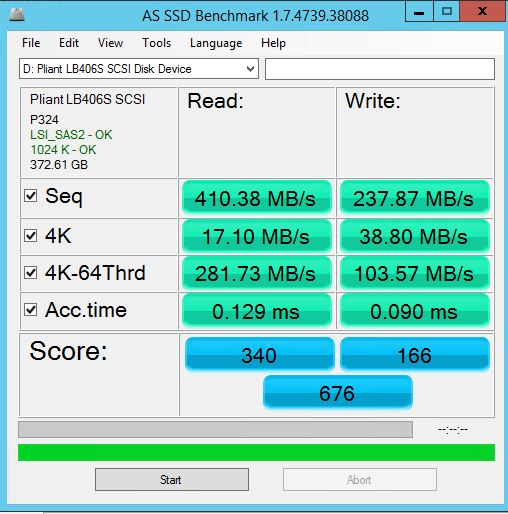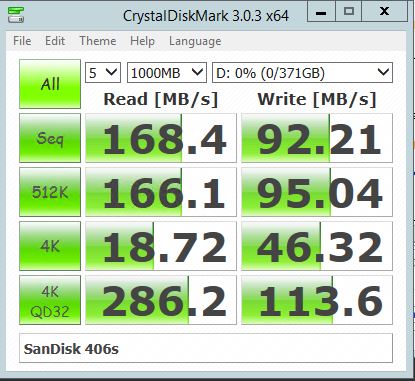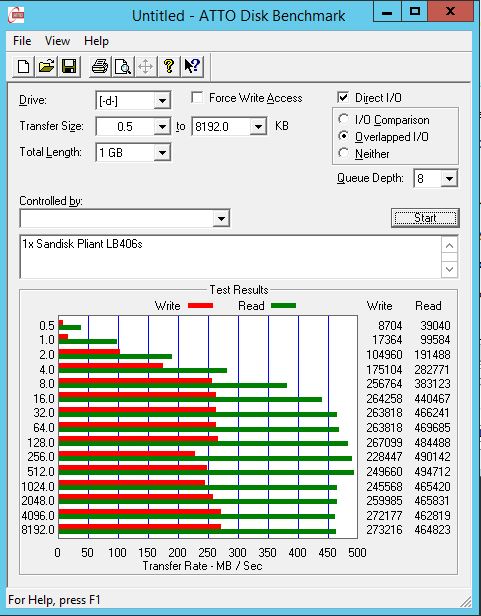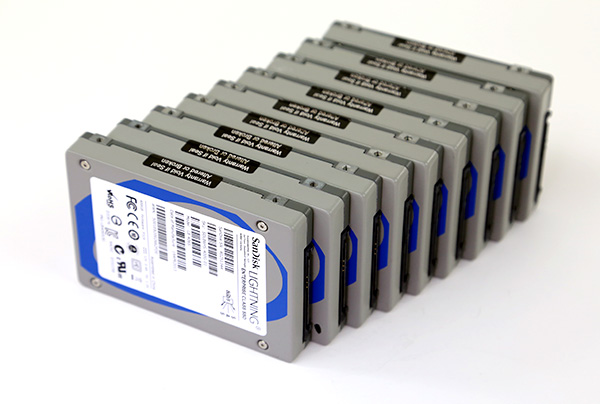Recently we have been working on a series taking previous-generation SLC and MLC SAS 2 SSDs through testing. Today we have quick benchmarks of the 400GB Pliant- SanDisk Lightning 406s (also know as the LB406s). Like the rest of the drives we have tested, the SanDisk Lightning 400GB SLC drives we purchased at under $0.60/GB which is comparable to newer reliable SATA SSDs. Previously we reviewed the SanDisk LB206s (200GB SLC version of this drive), Seagate Pulsar.2 200GB MLC and SanDisk Optimus 400GB MLC drives. These SanDisk drives (from the Pliant acquisition) had major design wins at major OEMs such as HP, Dell, NetApp and others so there are many of them on the secondary market and they did go through more validation on SAS controllers than some questionable consumer SATA drives released in the market.
A key feature of these drives is their SAS interface. While technically SATA over SAS works, when vendors are putting together arrays with thousands of drives, having a topology of just SAS versus mixed SATA and SAS makes sense. These SAS drives are dual ported for high-availability applications and SAS does do more error checking/ correction than SATA counterparts. The Lightning drives we have for testing are the SAS 2 6.0gbps versions that use SLC NAND. The NAND itself is 34nm also so it is much more durable than today’s ~20nm NAND, especially in SLC mode. The bottom line here is that these drives are build to be reliable and to withstand heavy write workloads in large RAID arrays.
Test Configuration
Since we are going to assume the use of already released hardware, we are using a legacy system for testing across the test suite:
- Motherboard: Gigabyte GA-7PESH3
- Processors: Dual Intel Xeon E5-2690 (V2)
- SAS Controller: (onboard LSI SAS2008 in IR mode)
- RAM: 64GB DDR3L-1600MHz ECC RDIMMs
- OS SSD: Kingston V300 240GB
We did not use our Intel Xeon E5-2600 V3 platforms because this series started prior to the embargo being lifted on that platform. The Gigabyte’s LSI controller found onboard is the same as can be found in countless platforms and cards such as the IBM ServeRAID M1015 and LSI 9211-8i. We decided to use this controller since it is an extremely popular first-generation 6gbps SAS II controller. For those looking to build value SAS SSD enabled arrays, the LSI SAS2008 is likely going to be the go-to controller. A major point here is that we are using a SAS controller. This means that one cannot compare results directly to consumer-driven setups where a SATA SSD is connected to an Intel PCH port. There is a latency penalty for going over the PCIe bus to a controller to SAS. It also is a reason NVMe is going to be a game changer in the enterprise storage space.
SanDisk 406s (lb406s) 400GB SLC SAS SSD Quick Benchmarks
It is important, especially with SSDs not to take a single test result at face value. One should look at a few different tests to get an idea of how the drives perform in different scenarios. To this end, AS SSD benchmark, CrystalDiskMark, ATTO all show different facets of performance. These are the simple/ quick benchmarks. In the near future we will do some comparisons with longer term write comparisons and latency testing that are closer to enterprise workloads. We are using a few of our standard tests to do a quick comparison to some of the other drives that have passed through the lab recently.
There is a lot more to come in terms of benchmarking and we will also look at the drives in RAID 0 configurations just to see if that changes the performance picture. This is certainly only considered some quick benchmarking for a relative idea in terms of performance.
AS SSD Benchmark
AS SSD is a solid benchmark that does not write compressible data to drives. The result is perhaps one of the best workstation SSD benchmarks available today.

The AS SSD performance is fairly solid. Compared to the 200GB version of the drive we see about a 100MB/s improvement in sequential read speeds and a similar improvement in 4K-64 Thread read times. Perhaps more interesting is that the 4K-64 Thread write result went from 35MB/s on the 200GB model to 104MB/s on the 400GB model.
CrystalDiskMark
CrystalDiskMark is another benchmark which gives non-compressible read/write numbers. This is in contrast to the ATTO Benchmark used by LSI/ Sandforce and its partners when they market a given solid state drive.

CrystalDiskMark results were less than stellar. The 4K and 4K-QD32 results were significantly higher than on the SanDisk Lightning 200GB SLC drive so we are seeing a clear pattern emerging.
ATTO Benchmark
The value of the ATTO benchmark is really to show the best-case scenario. ATTO is known to write highly compressible data to drives, which inflates speeds of controllers that compress data like LSI/ SandForce does prior to writing on a given solid state drive.

Our Atto benchmark shows the SanDisk Lightning 400GB SLC drive with 460MB/s read speeds with writes capping in the 273MB/s range. On one hand, these are not mind-blowing figures but certainly are significantly better than 15K RPM 2.5″ spinning disks or first generation SAS SSDs.
Conclusion
These SanDisk Lightning drives are certainly not for everyone, especially if you have a small 1-2 drive ultra low power server. On the other hand, if you have a larger RAID array, a write heavy workload or similar deployments, these are interesting drives. The key features here are a 5-year warranty and the SLC NAND which has been rated at around 10 full disk writes per day for five years. Performance is not stellar, but these are direct write to NAND designs, so writes are not cached and not as vulnerable to power loss data loss. Frankly, most applications will not be that write heavy to write 4TB/ drive constantly for that long which is perhaps the point. From our initial testing of the SanDisk Lightning 400GB SLC drives, performance is acceptable, SAS interface, 34nm SLC for endurance and you get a solid SSD for many workloads.





Noob buy normal server motherboard and normal server sas raid controller (not оnboard !)